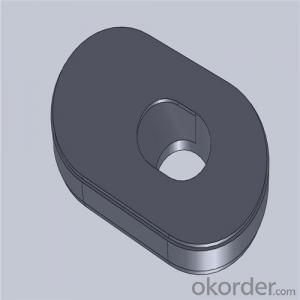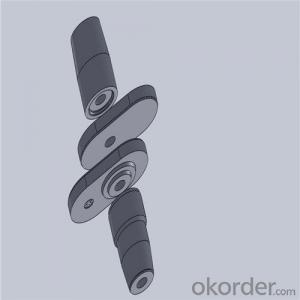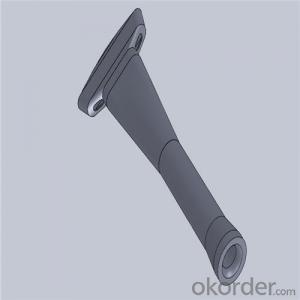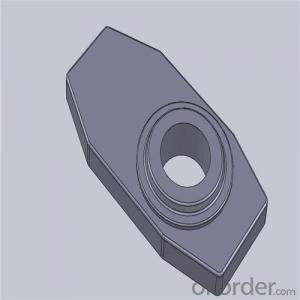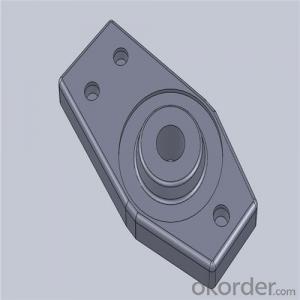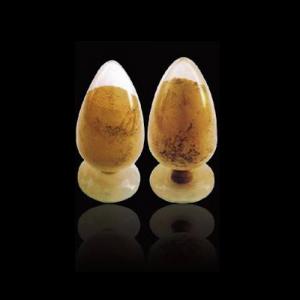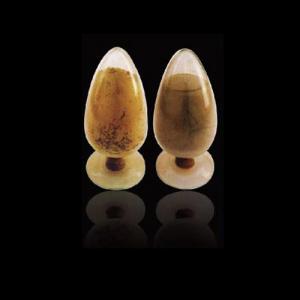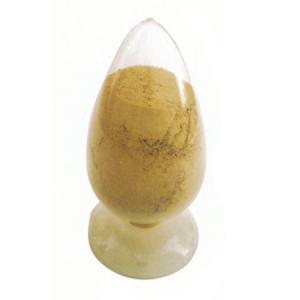High Performance&Temperature Ladle Sliding Gate Steel Industry
- Loading Port:
- Shanghai
- Payment Terms:
- TT OR LC
- Min Order Qty:
- 100 pc
- Supply Capability:
- 1000 pc/month
OKorder Service Pledge
OKorder Financial Service
You Might Also Like
Quick Details for High Performance Refractory Ladle Slide Gate
| Place of Origin: | China (Mainland) | Shape: | Plate | Material: | Alumina Block |
| SiO2 Content (%): | N/A | Al2O3 Content (%): | 80-90% | MgO Content (%): | N/A |
| CaO Content (%): | N/A | Refractoriness (Degree): | 1770°< Refractoriness< 2000° | CrO Content (%): | N/A |
| SiC Content (%): | N/A | Model Number: | CS80 | Brand Name: | |
| Product name: | High performance refractory ladle slide gate | Model No.: | cs80 | Brand name: | CMAX |
| Quality: | Al-C or Al-Zr-C | Service life: | 4-6 heats | Apparent porosity: | 7% Max |
| Bulk density:: | 3.1 MIN | C.C.S: | 120MPA | MOQ: | 100 pcs for trial |
| Delivery time: | 60 working days upon receipt of deposit |
Packaging & Delivery
| Packaging Details: | Inner carton packing, outer wooden case suitable for long term sea shipping |
| Delivery Detail: | three months working days upon receipt of deposit |
Specifications
Surface flatness less than 0.05mm
High mechanical strength
Erosion resistance
Oxidation resistance
Thermal shock stability
Slide gate plate widely including Alumina carbon and Alumina Zirconia Carbon slide gate plate, MgO and MgO-spinel slide gate plate,nonoxides bonding slide gate plateand unburned slide gate plate.
General Chemical Analysis for refractory ladle slide gate :
Alumina -Zirconia-Carbon material
| Al-Zr-C Material | |||||
| Al2O3 | C | ZrO2 | Apparent porosity | Bulk density | C.C.S |
| (% minm) | (% minm) | (% minm) | (% max) | (gm./cc minm) | (MPa minm) |
| 85 | 3 | 5 | 7 | 3.1 | 120 |
| 85 | 3 | 4 | 7 | 3.1 | 120 |
Composite type: Al-Zr-C for working line, outer Al-C material
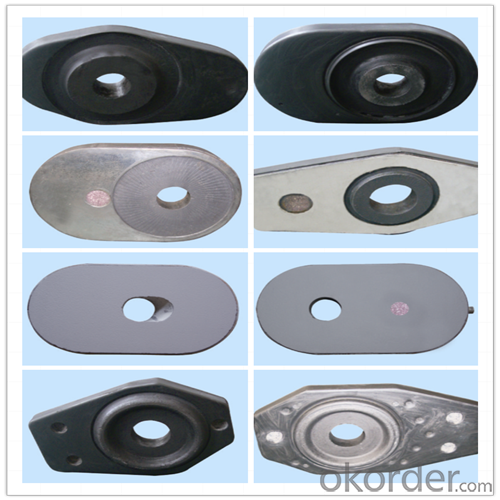
| Al-Zr-C & Al-C Material | ||||||
| Al2O3 | C | ZrO2 | Apparent porosity | Bulk density | C.C.S | |
| (% minm) | (% minm) | (% minm) | (% max) | (gm./cc minm) | (MPa minm) | |
| Inner side (Working face) | 85 | 3 | 4 | 7 | 3.1 | 120 |
| Outside | 90 | 3 | 0 | 9 | 3 | |

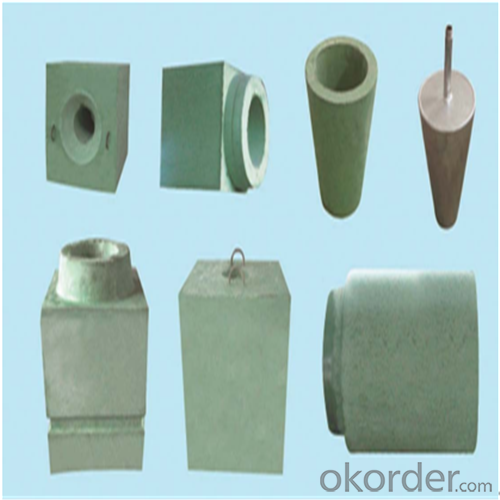
About us

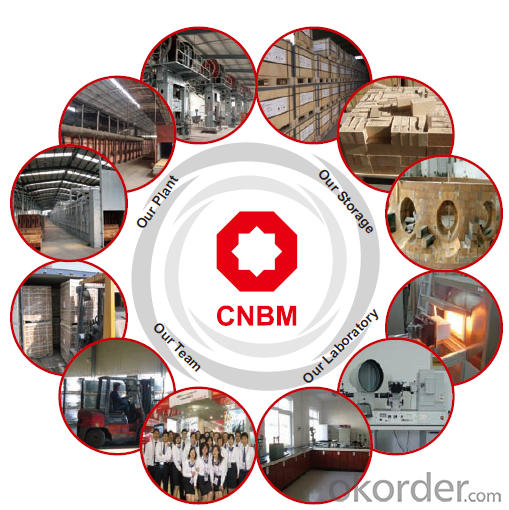
Sample is on your request.
Welcome to visit our factory~
- Q:What are the key characteristics of monolithic refractories for electric arc furnace applications?
- Monolithic refractories for electric arc furnace applications have several key characteristics that make them suitable for the harsh conditions and high temperatures encountered in these environments. Firstly, monolithic refractories offer excellent thermal shock resistance. Electric arc furnaces operate at extremely high temperatures, and the rapid temperature changes that occur during the melting and refining processes can cause significant thermal stress. Monolithic refractories are designed to withstand these thermal shocks without cracking or spalling, ensuring the longevity and performance of the lining. Secondly, monolithic refractories have high resistance to chemical attack. Electric arc furnaces involve the melting and refining of various metals and alloys, which can create highly corrosive atmospheres. Monolithic refractories are formulated with chemically inert materials and additives that provide resistance to the corrosive effects of molten metals and slag, protecting the lining from chemical degradation. Another important characteristic of monolithic refractories for electric arc furnace applications is their high refractoriness. Refractoriness refers to the ability of a material to retain its strength and integrity at high temperatures. Electric arc furnaces typically operate at temperatures above 1500°C, and monolithic refractories are designed to withstand these extreme conditions without significant loss of properties or degradation. Furthermore, monolithic refractories offer good thermal conductivity. This property allows for efficient heat transfer throughout the lining, ensuring uniform heating and melting of the charge material. It also helps to minimize hot spots and thermal gradients, which can lead to uneven wear and premature failure of the lining. Lastly, monolithic refractories are known for their ease of installation and repair. Unlike traditional brick or block refractories, monolithic materials can be cast, sprayed, or rammed into place, eliminating the need for complex masonry work. This not only saves time and labor but also allows for easy maintenance and repair of the lining, reducing downtime and improving overall furnace efficiency. In summary, the key characteristics of monolithic refractories for electric arc furnace applications include excellent thermal shock resistance, high chemical resistance, high refractoriness, good thermal conductivity, and ease of installation and repair. These properties make monolithic refractories ideal for withstanding the harsh conditions and demanding requirements of electric arc furnace operations.
- Q:How do monolithic refractories withstand the thermal cycling in aluminum smelting applications?
- Monolithic refractories have been specifically developed to endure the extreme thermal cycling conditions that arise in aluminum smelting applications. The exceptional properties of these refractories enable them to withstand the rapid and repetitive heating and cooling cycles without experiencing significant damage or failure. A key characteristic of monolithic refractories is their remarkable thermal shock resistance, which allows them to withstand sudden temperature changes without cracking or spalling. Throughout the aluminum smelting process, the refractories are exposed to extreme temperatures when molten aluminum is poured into the molds or when the molten metal comes into contact with the refractory lining. It is essential for the refractories to quickly absorb and dissipate heat to prevent any thermal shock damage. Furthermore, monolithic refractories possess a high thermal conductivity, which facilitates the efficient transfer of heat away from the refractory lining. This effectively reduces the risk of thermal stress and thermal fatigue. By dispersing the heat generated during the smelting process, the refractories minimize temperature variations within the lining, thereby preventing the occurrence of cracks or fractures. Moreover, monolithic refractories exhibit excellent chemical resistance, a crucial characteristic in aluminum smelting applications. These refractories are formulated to resist the corrosive effects of molten aluminum and other chemicals present in the smelting process. By offering resistance to chemical corrosion, the refractories help maintain the integrity of the refractory lining and extend its service life. Additionally, monolithic refractories are often reinforced with fibers or other structural materials to enhance their mechanical strength and durability. These reinforcements provide added resistance against mechanical stresses, such as thermal expansion and contraction, which arise during the thermal cycling process. In conclusion, the purpose of monolithic refractories is to withstand the thermal cycling conditions encountered in aluminum smelting applications. Their exceptional thermal shock resistance, high thermal conductivity, excellent chemical resistance, and enhanced mechanical strength enable them to endure extreme temperature fluctuations without experiencing significant damage. These refractories play a crucial role in maintaining the integrity and efficiency of the smelting process in the aluminum industry.
- Q:What are the advantages of using insulating castables in the iron and steel industry?
- There are several advantages of using insulating castables in the iron and steel industry. Firstly, insulating castables provide excellent thermal insulation. They have low thermal conductivity, which helps to minimize heat loss from the furnaces and other equipment. This is particularly important in the iron and steel industry, where high temperatures are required for various processes. The insulation provided by castables helps to maintain a stable temperature within the furnace, resulting in improved energy efficiency and reduced fuel consumption. Secondly, insulating castables have high strength and excellent resistance to thermal shock. This is crucial in the iron and steel industry, where extreme temperature changes are common. The castables can withstand rapid heating and cooling cycles without cracking or compromising their structural integrity. This ensures the longevity and durability of the refractory lining, reducing the need for frequent maintenance and repairs. Furthermore, insulating castables are lightweight and easy to install. Their low density makes them easier to handle and transport, resulting in reduced labor costs and shorter installation times. This is particularly advantageous in large-scale iron and steel plants, where time and cost efficiency are critical. Moreover, insulating castables offer good corrosion resistance. The harsh environment in the iron and steel industry, with the presence of molten metal, slag, and various chemicals, can cause corrosion and erosion of refractory materials. Insulating castables are designed to withstand these corrosive conditions, ensuring the longevity of the lining and minimizing the risk of downtime and production disruptions. Lastly, insulating castables are versatile and can be customized to meet specific requirements. They are available in various compositions and densities, allowing for tailored solutions to different applications within the iron and steel industry. This versatility ensures optimal performance and efficiency in various furnace and equipment designs. In conclusion, the advantages of using insulating castables in the iron and steel industry include excellent thermal insulation, high strength, resistance to thermal shock, lightweight installation, corrosion resistance, and versatility. These benefits contribute to improved energy efficiency, reduced maintenance costs, increased durability, and enhanced overall productivity in the industry.
- Q:How do monolithic refractories enhance the performance of ladle and tundish covers?
- The performance of ladle and tundish covers is significantly improved by the utilization of monolithic refractories. There are several ways in which this enhancement is achieved. Primarily, monolithic refractories possess remarkable thermal insulation properties. The steelmaking process subjects ladles and tundishes to extreme temperatures. Through the use of monolithic refractories, the covers effectively trap and retain heat, preventing excessive heat loss. This insulation ability not only helps maintain the desired temperature of the molten steel but also reduces the energy consumption required for heating. Secondly, monolithic refractories demonstrate exceptional resistance to thermal shock. When ladles and tundishes are filled with molten steel, there is a rapid and drastic temperature change in the refractory lining. This sudden shift can cause cracking and spalling of the lining, jeopardizing its integrity. However, monolithic refractories possess high thermal shock resistance, enabling them to endure these abrupt temperature fluctuations without significant damage. This ensures the longevity and durability of the ladle and tundish covers. Additionally, monolithic refractories exhibit excellent corrosion resistance. The presence of molten steel and other corrosive substances in ladles and tundishes can erode the refractory lining over time. Nonetheless, monolithic refractories are specifically engineered to withstand these corrosive environments, shielding the covers from chemical attack and erosion. This corrosion resistance enhances the lifespan of the ladle and tundish covers, reducing the need for frequent replacements and associated downtime. Furthermore, monolithic refractories provide good mechanical strength and stability. Ladles and tundishes undergo various mechanical stresses, including the weight of the molten steel, thermal expansions, and vibrations. The use of monolithic refractories furnishes the necessary strength and stability to endure these mechanical forces, averting structural failures and maintaining the integrity of the covers. To summarize, monolithic refractories heighten the performance of ladle and tundish covers by providing exceptional thermal insulation, resistance to thermal shock and corrosion, and sufficient mechanical strength. These properties guarantee efficient steelmaking processes, diminish maintenance costs, and extend the lifespan of ladles and tundishes.
- Q:How do monolithic refractories perform in blast furnace taphole applications?
- Monolithic refractories perform excellently in blast furnace taphole applications due to their high thermal resistance, mechanical strength, and resistance to chemical attack. They are able to withstand the extreme temperatures and abrasive conditions of the blast furnace discharge, ensuring reliable and efficient operation of the taphole. Additionally, monolithic refractories offer easy installation and maintenance, reducing downtime and improving overall productivity in the blast furnace.
- Q:How do monolithic refractories contribute to energy efficiency in iron and steel manufacturing?
- The use of monolithic refractories is crucial for improving energy efficiency in iron and steel manufacturing processes. Made from a single material, typically a combination of high-quality aggregates, binders, and additives, these refractories are easily installed and repaired. One way in which monolithic refractories enhance energy efficiency is by minimizing heat loss. Their excellent insulation properties help maintain high temperatures in the furnace or kiln. This reduces the energy needed to maintain the desired temperature, resulting in lower energy consumption and cost savings. Additionally, monolithic refractories are designed with high thermal conductivity, allowing for efficient heat transfer from hot gases or flames to the iron and steel being processed. This leads to faster heating rates and shorter processing times, resulting in energy savings and increased production capacity. Another advantage of monolithic refractories is their ability to withstand extreme temperatures and harsh conditions. They are resistant to thermal shock, corrosion, and erosion, which extends their lifespan and reduces the need for frequent repairs or replacements. This minimizes downtime, enabling continuous operation and improved energy efficiency. Moreover, monolithic refractories offer design flexibility, allowing for the optimization of furnace and kiln geometries. By customizing the shape and dimensions of the refractory linings, heat distribution can be improved, ensuring more uniform heating and reducing energy wastage. This flexibility also enables the implementation of advanced combustion technologies, further enhancing energy efficiency. In conclusion, monolithic refractories contribute to energy efficiency in iron and steel manufacturing through the reduction of heat loss, enhancement of heat transfer, ability to withstand extreme conditions, optimization of furnace geometries, and facilitation of advanced combustion technologies. By utilizing these refractories, the industry can achieve significant energy savings, cost reductions, and environmental benefits.
- Q:What are the common failure mechanisms of monolithic refractories?
- Some common failure mechanisms of monolithic refractories include thermal shock, spalling, erosion, chemical attack, and mechanical stress. These factors can weaken the refractory material, causing it to crack, break, or deteriorate over time.
- Q:How do monolithic refractories provide thermal insulation in the iron and steel industry?
- Monolithic refractories play a crucial role in providing thermal insulation in the iron and steel industry. These refractories are commonly used to line the furnaces and other high-temperature equipment used in the production processes. One way monolithic refractories provide thermal insulation is by their ability to withstand high temperatures without degrading or melting. They are designed to have high heat resistance, which allows them to be used in environments where temperatures can reach several thousand degrees Celsius. By withstanding these extreme temperatures, the refractories prevent the transfer of heat to the surrounding structure, thus providing insulation. Another way monolithic refractories provide thermal insulation is through their low thermal conductivity. These materials have a low thermal conductivity, meaning they are not efficient in conducting heat. Instead, they trap the heat within their structure and minimize its transfer to the surrounding equipment or environment. This characteristic helps to maintain the temperature inside the furnaces and other high-temperature equipment, allowing for efficient and controlled metal production. Furthermore, monolithic refractories can be applied as a thick lining layer, which creates an additional barrier between the high-temperature environment and the surrounding equipment. The thickness of the refractory lining helps to minimize heat transfer and acts as a buffer, reducing the impact of high temperatures on the structural integrity of the equipment. In addition to providing thermal insulation, monolithic refractories also offer excellent resistance to chemical attack and mechanical wear, which are common challenges in the iron and steel industry. This resistance ensures the longevity of the refractory lining, allowing for consistent and reliable insulation over time. Overall, monolithic refractories provide thermal insulation in the iron and steel industry through their high-temperature resistance, low thermal conductivity, thick lining layer, and resistance to chemical attack and mechanical wear. These properties contribute to maintaining the desired temperature inside the equipment and protecting the surrounding structure from the intense heat generated during metal production processes.
- Q:What are the key properties of shotcrete mixes used for monolithic refractory applications?
- The key properties of shotcrete mixes used for monolithic refractory applications include high strength, low porosity, high abrasion resistance, good thermal shock resistance, and excellent adhesion to the substrate. These properties ensure the durability and effectiveness of the shotcrete in withstanding high temperatures and harsh conditions in refractory applications.
- Q:How do monolithic refractories contribute to the overall productivity of iron and steel plants?
- Monolithic refractories play a crucial role in enhancing the overall productivity of iron and steel plants in several ways. Firstly, their high thermal conductivity and insulation properties help to maintain and regulate the temperature inside the furnaces, ensuring efficient and consistent heat distribution. This facilitates the optimal melting and refining of iron and steel, reducing energy consumption and improving productivity. Additionally, monolithic refractories offer excellent resistance to chemical attacks, such as the corrosive effect of molten metals and slags. This resistance enables longer refractory lifespan, reducing downtime for repairs and replacements, and ultimately maximizing the plant's operational efficiency. Moreover, the monolithic nature of these refractories allows for easy installation and repair, minimizing the time and effort required for maintenance activities. This quick and efficient process further contributes to the overall productivity of iron and steel plants by reducing production disruptions. In summary, monolithic refractories enhance the overall productivity of iron and steel plants by providing efficient heat management, superior chemical resistance, and easy maintenance, leading to improved energy efficiency, reduced downtime, and enhanced operational efficiency.
1. Manufacturer Overview |
|
|---|---|
| Location | |
| Year Established | |
| Annual Output Value | |
| Main Markets | |
| Company Certifications | |
2. Manufacturer Certificates |
|
|---|---|
| a) Certification Name | |
| Range | |
| Reference | |
| Validity Period | |
3. Manufacturer Capability |
|
|---|---|
| a)Trade Capacity | |
| Nearest Port | |
| Export Percentage | |
| No.of Employees in Trade Department | |
| Language Spoken: | |
| b)Factory Information | |
| Factory Size: | |
| No. of Production Lines | |
| Contract Manufacturing | |
| Product Price Range | |
Send your message to us
High Performance&Temperature Ladle Sliding Gate Steel Industry
- Loading Port:
- Shanghai
- Payment Terms:
- TT OR LC
- Min Order Qty:
- 100 pc
- Supply Capability:
- 1000 pc/month
OKorder Service Pledge
OKorder Financial Service
Similar products
New products
Hot products
Related keywords

